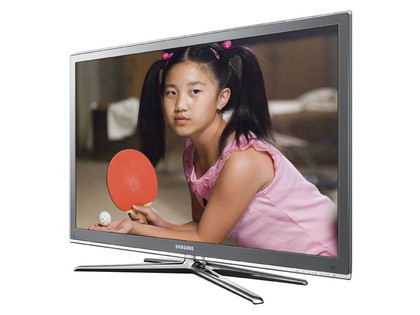Why you can trust TechRadar

Sound
Given how ridiculously thin the 40C8000 is, its downward-firing speakers crafted into the rear of the panel are surprisingly clear. There are a number of preset modes comprising standard, music, movie, clear voice and amplify, with the latter intended to boost high-frequency sounds for the benefit of the hearing impaired.
In practice, there's little difference between each one and the likelihood is that once one mode is selected it gets forgotten about – at least for a while – so it's worth choosing your preferred mode for everyday viewing and just switching to an external multichannel sound system for dramas, movies and so forth.
Value
Samsung seems to have priced the C8000 range far more realistically than its flagship UC9000 series. Prices can vary greatly, of course, but the £1,300 typically being asked by retailers doesn't look unreasonable for as highly specified a screen as this.
You can probably score yourself an LG 42LX6900 with mostly similar features for a bit less but the likes of Panasonic's TX-P42VT20 plasma is painfully pricey at £500 more than the Samsung (although its 3D performance is much better with reduced crosstalk).
Ease of use
Sign up for breaking news, reviews, opinion, top tech deals, and more.
Setting up and using the 40UC8000 is not the ordeal of some TVs, but is more of a challenge than it should be. There's a terrific amount of technology packed in under the hood and while the instruction manual is nicely laid out with good clear descriptions the onscreen menu structure is a bit of a muddle.
It's good that the Tools button on the remote provides shortcuts to a number of features such as the picture mode, Anynet+ (networking), audio adjustments and energy saving settings but several adjustments and functions seem randomly distributed.
It would be much more helpful if the source menu could be edited so that only active inputs appeared in the list, reducing the amount of scrolling to get from say Freeview to Sky or Blu-ray coming in on an HDMI.
No complaints about the Freeview EPG, which gives you two hours' worth of programmes across six channels, with the live broadcast showing in the top left corner. The full EPG information is comprehensive and you can set reminders or the USB record timer. The quick view programme info bar is also superior, with full EPG scrollable access rather than just the more common 'now and next.'
The set isn't fussy about what device it will record to, pretty much any make or model over 4GB should work except RAID type hard-disk drives. With automatic recording activated you can treat the set as a PVR with live pausing, fast forward and so on. What you can't do is take the drive and watch the recordings on another screen or copy them to another drive.
The internet TV portal has an encouraging opening page with sizeable icons for each service and a large Samsung App store window. Some services are more user-friendly than others. The iPlayer is a real boon and the likes of YouTube and Getty Images are straightforward, but the Rovi TV guide lists only 15 channels (none in HD), it's impossible to zoom in on Google Maps and a pain to enter text using the remote control.
Clearly, connected TV services are not yet the finished article.
The 3D experience is not as problematic as some. The active specs are pretty comfy and the dedicated 3D button on the remote makes it easy to engage and disengage 3D. You have to choose which type of 3D source (side-by-side, frame sequential or 2D-to-3D) it is but it's about as efficient as you get without a fully automatic process.
Current page: Samsung UE46C8000: Sound, value and ease of use
Prev Page Samsung UE46C8000: Picture Next Page Samsung UE46C8000: Verdict